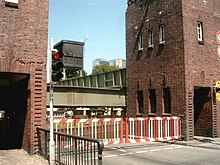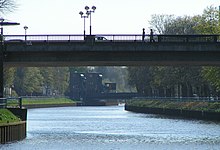Cecilia Bridge
The Cäcilienbrücke is a lift bridge over the Hunte or the coastal canal in Oldenburg . It connects the city center with the Easter castle district and was built in its current form in 1927 on the site of an older Cäcilienbrücke from 1832.
The bridge as well as the Oldenburg lock is operated by the Bremen Waterways and Shipping Office as a machine facility of importance for shipping .
location

The bridge crosses the canalised river about 500 m from the confluence of the Hunte into the canal. On the other side, the bridge is around 1 km from Oldenburg harbor. The bridge is one of five road bridges over the Hunte, which cross the partially canalised river in the area of the city of Oldenburg, and the only lifting bridge in Oldenburg. In addition to the Cäcilienbrücke, the Niedersachsendamm , the Amalienbrücke and the two motorway bridges of the A 28 ( Hochstraße Oldenburg ) and the A 29 are further river crossings in Oldenburg. The Niedersachsendamm and the A 28 lie south of the Cäcilienbrücke, the A-29 bridge and the Amalienbrücke north of it. In addition to these bridges over the Hunte, there is also another bridge in the Oldenburg city area, which is located at the entrance to Hundsmühlen , but only crosses the coastal canal and not the Hunte.
The bridge is oriented in an east-west direction and is located between the city center, the judicial district (the original Oldenburg) and the district of Osternburg (the original community of Osternburg), which is on the other side of the river when viewed from the city center. The bridge connects the street Damm (Oldenburg) and the Bremer Straße (Easter castle). In the immediate vicinity of the bridge are the State Museum for Nature and Man , the Oldenburg Department of the Lower Saxony State Archives and the Graf-Anton-Günther-Gymnasium .
The bridge
The bridge consists of two brick towers on both banks and a steel lane . The carriageway includes two asphalt lanes for cars and bicycles as well as one lane for pedestrians on each side, separated by a wall, at lifting height.
The bridge has a span of 40.80 m. The roadway is 5.50 m wide, if you include the floor plan of the towers, the total width is 10.30 m. The lifting device pulls the roadway upwards by 3.50 m with a MAN machine system and steel cables to enable ships to pass through.
The keeper's house is above the north footpath in the middle of the bridge. The switching house on the northwestern bank is an outbuilding.
When the bridge is up, pedestrians and cyclists can use stairs inside the towers to get onto the bridge and thus reach the other bank.
history
Up until the 18th century, there was a ford at the site of today's Cäcilienbrücke, which made it possible to cross the Hunte. The dam , after which the western access road is named, used to be a stick dam in the middle of the boggy marshland that surrounded Oldenburg. The road was part of a trade route that led from Westphalia via Oldenburg to Bremen and strengthened the city's role as a trading center.
The construction of a wooden bridge on the dam is recorded for the year 1752 . Grand Duke Paul Friedrich August had the bridge expanded into a stone arch construction in 1832 and named it after his wife Cäcilie von Sweden . In addition to the bridge, the Cäcilienschule Oldenburg is named after her.
With the construction of the coastal canal in the 1920s, the Hunte also had to be navigable for large ships up to 600 gross tons , so there was a need for a higher bridge. Since this was not possible under the given structural conditions, the state of Oldenburg decided to build a lifting bridge. The bridge was designed by Adolf Rauchheld , the Oldenburg government's building minister at the time. In 1927, in the same year as the similar old Amalienbrücke, the Cecilia Bridge was completed and was temporarily the largest lift bridge in Europe. The Oldenburg trolleybus also ran across the bridge.
Towards the end of the Second World War, the roadway was blasted to make it more difficult for the Allied troops to cross the Hunte. It was then rebuilt and has been fully restored since 1948. The steel and electrical engineering trades were assigned to the MAN plant in Gustavsburg .
In February 2013, at a meeting of the Transport Committee of the City of Oldenburg, the responsible waterways and shipping authorities stated that they intended to demolish the current bridge and replace it with a completely new structure. The office justified the project with the fact that both the masonry and the foundation as well as the lifting mechanism of the listed bridge show severe damage, which makes renovation impossible for safety and cost reasons. Construction work was scheduled to begin in 2017. In April 2018, the end of the planning approval procedure was planned for the second half of 2018 and the start of construction in 2020 at the earliest. The design presented for this by the Hamburg architect Joachim Kahl refers to the previous construction.
In the summer of 2018, the lifting of the bridge for shipping had to be stopped for 80 days because the superstructure expands too much in the heat and affects the lifting mechanism. From July to the end of September 2019, the bridge was closed to car traffic because the lifting mechanism did not work due to the dilapidation at temperatures above 20 degrees Celsius. In order to guarantee ship traffic, the bridge was raised by 1.60 m and was only passable for bicycles and pedestrians. A temporary bridge is planned for the time of the new construction (probably 2022 ).
The old bridge was taken out of service on April 24, 2020.
On May 9, 2020, the lifting part was removed with the help of a floating crane.
Web links
- The Cäcilienbrücke on the side of the WSA Bremen
- Historical photo gallery of the old bridges
- Cäcilienbrücke: Without a ford there is no Oldenburg , Oldenburger online newspaper
Individual evidence
- ^ Cäcilienbrücke: No ford, no Oldenburg , Oldenburger online newspaper.
- ↑ From the ford to the Cecilia bridge. In: NWZOnline.de. July 23, 2014, accessed January 31, 2015 .
- ↑ Cäcilienbrücke is demolished. In: NWZOnline.de. February 12, 2013, accessed February 12, 2013 .
- ↑ Patrick Buck: Plans presented in Oldenburg: This is how the new Cäcilienbrücke should look. In: NWZOnline.de. March 16, 2018, accessed April 5, 2018 .
- ^ Cäcilienbrücke: Temporary bridge is being built . In: Oldenburger Onlinezeitung, March 29, 2019.
- ↑ Cäcilienbrücke closed to cars . In: Norddeutscher Rundfunk , July 6, 2019.
- ↑ Waterways and Shipping Office informs: Cäcilienbrücke can be used again . Website of the city of Oldenburg. Retrieved October 7, 2019.
- ↑ Thomas Husmann: Cäcilienbrücke free again this Monday . In: Nordwest-Zeitung , September 30, 2019.
- ↑ Closure of the Cäcilienbrücke and commissioning of the temporary bridge. oldenburg.de, accessed on April 27, 2020 .
- ↑ Nordwest-Zeitung: Cäcilienbrücke Oldenburg: Pictures of the dismantling of the lifting part. Retrieved May 10, 2020 .
Coordinates: 53 ° 7 ′ 59 ″ N , 8 ° 13 ′ 12 ″ E





